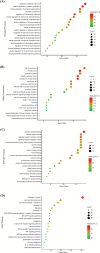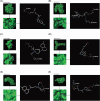Network Pharmacological Analysis of Hydroxychloroquine Intervention in the Treatment of Iga Nephropathy
- PMID: 39492771
- PMCID: PMC12246745
- DOI: 10.2174/0113816128347345241028063515
Network Pharmacological Analysis of Hydroxychloroquine Intervention in the Treatment of Iga Nephropathy
Abstract
Background: IgA nephropathy (IgAN) is the most prevalent primary glomerulonephritis globally and has a high propensity to develop into end-stage renal disease (ESRD). Hydroxychloroquine has been proven to reduce proteinuria in IgAN patients, but the precise mechanism remains unclear. Therefore, network pharmacology was used to investigate the mechanism.
Methods: PubChem and SwissADME databases were utilized to acquire the structure of hydroxychloroquine. The SwissTargetPrediction, PharmMapper, DrugBank, TargetNet, and BATMAN-TCM databases were then utilized to obtain the targets. The target genes related to IgAN were then gathered from the databases, which included GeneCards, PHARMGKB, DrugBank, OMIM, and DisGeNET. Common targets were obtained by UniProt. Gene Ontology (GO) and Kyoto Encyclopedia of Genes and Genomes (KEGG) enrichment analyses were performed to define the main molecular mechanisms and pathways. Furthermore, a protein-protein interaction (PPI) network was constructed using the STRING tool, and the core targets were obtained by Cytoscape. Finally, molecular docking between the core targets and hydroxychloroquine was performed.
Results: 167 common target genes were acquired by overlapping. The core targets were TNF, ALB, IL1B, JUN, FOS, SRC, and MMP9. The GO and KEGG results showed the targets to be related to the production of inflammatory cytokines and chemokines and were engaged in the toll-like receptor (TLR) signaling pathway. At the same time, the molecular docking results showed that the core targets all combined with hydroxychloroquine closely.
Conclusion: This study proved that hydroxychloroquine may treat IgAN through the TLR signaling pathway, and the restraint of TNF, TLR, IL1B, and JUN may be essential for the treatment.
Keywords: Hydroxychloroquine; IgA nephropathy; end-stage renal disease.; network pharmacology; signaling pathway; toll-like receptor.
Copyright© Bentham Science Publishers; For any queries, please email at epub@benthamscience.net.
Conflict of interest statement
The authors declare no conflict of interest, financial or otherwise.
Figures



Similar articles
-
Exploring the mechanism of proteinuria reduction by hydroxychloroquine in IgA nephropathy using network pharmacology and molecular mocking.Sci Rep. 2025 Jul 1;15(1):20836. doi: 10.1038/s41598-025-97950-z. Sci Rep. 2025. PMID: 40593236 Free PMC article.
-
Identifying the potential therapeutic targets of tertiary lymphoid structure in IgA nephropathy based on bioinformatics.Autoimmunity. 2025 Dec;58(1):2519285. doi: 10.1080/08916934.2025.2519285. Epub 2025 Jun 23. Autoimmunity. 2025. PMID: 40549784
-
Mechanism of Salvia miltiorrhiza in the treatment of periodontitis: integrative analyses via network pharmacology, molecular dynamics, and cellular assays.BMC Complement Med Ther. 2025 Jul 28;25(1):291. doi: 10.1186/s12906-025-05040-4. BMC Complement Med Ther. 2025. PMID: 40721767 Free PMC article.
-
Study on the mechanism of Shujin Tongluo granules in treating cervical spondylosis based on network pharmacology and molecular docking.Medicine (Baltimore). 2023 Jul 21;102(29):e34030. doi: 10.1097/MD.0000000000034030. Medicine (Baltimore). 2023. PMID: 37478234 Free PMC article.
-
Exploring the mechanism of ShenGui capsule in treating heart failure based on network pharmacology and molecular docking: A review.Medicine (Baltimore). 2024 Apr 5;103(14):e37512. doi: 10.1097/MD.0000000000037512. Medicine (Baltimore). 2024. PMID: 38579077 Free PMC article. Review.
References
MeSH terms
Substances
Grants and funding
LinkOut - more resources
Full Text Sources
Miscellaneous

